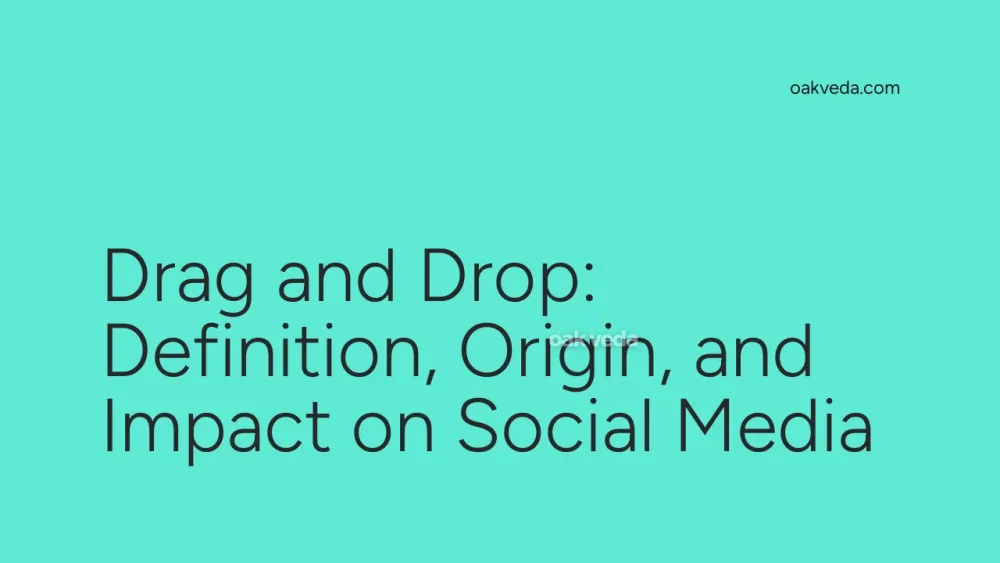
What is Drag and Drop?
Drag and drop is a user-friendly method of moving virtual objects from one location to another within a digital interface. In the context of social media management, it refers to the ability to schedule and rearrange content by simply clicking, dragging, and releasing items on a content calendar or planner.
Origin and Development of Drag and Drop
The concept of drag and drop has been around since the early days of graphical user interfaces (GUIs). It was first introduced by Jef Raskin in the late 1970s as part of the Apple Macintosh project. Over time, this intuitive interaction method has evolved and found its way into various applications, including social media management tools.
How Drag and Drop Works in Social Media Management
In social media management platforms, drag and drop functionality allows users to:
- Schedule posts by dragging content onto specific dates and times on a calendar
- Rearrange planned posts by moving them to different time slots
- Organize visual content to create an aesthetically pleasing feed
- Bulk schedule multiple posts at once
This feature significantly streamlines the content planning process, making it more efficient and user-friendly.
Types of Drag and Drop Features in Social Media Tools
- Calendar-based drag and drop: Allows users to schedule posts by dragging them onto specific dates and times on a content calendar.
- Visual planner drag and drop: Enables users to arrange and rearrange visual content to create an appealing grid layout for platforms like Instagram.
- Bulk scheduling drag and drop: Facilitates the scheduling of multiple posts at once by dragging a group of content items to designated time slots.
Popular Examples of Drag and Drop in Social Media Management
Several social media management tools have incorporated drag and drop features to enhance user experience:
- Later: Offers a robust drag and drop functionality for scheduling content and designing Instagram feeds.
- Hootsuite: Provides a drag and drop interface for rearranging scheduled posts across multiple platforms.
- Buffer: Allows users to drag and drop content between different social media accounts and time slots.
- Planoly: Features a visual planner with drag and drop capabilities for Instagram feed design.
Impact of Drag and Drop on Social Media Culture
The introduction of drag and drop features in social media management tools has had a significant impact on digital marketing strategies and content creation:
- Increased efficiency: Marketers can plan and schedule content more quickly, saving valuable time.
- Improved visual consistency: Drag and drop visual planners help maintain a cohesive aesthetic across social media profiles.
- Enhanced flexibility: Users can easily adjust their content strategy by rearranging posts as needed.
- Streamlined workflow: The intuitive nature of drag and drop reduces the learning curve for new users and simplifies the content management process.
How Brands and Influencers Use Drag and Drop
Brands and influencers leverage drag and drop features to:
- Plan content calendars weeks or months in advance
- Maintain a consistent posting schedule
- Create visually appealing Instagram grids
- Optimize post timing based on audience engagement data
- Collaborate with team members on content planning
For example, a fashion brand might use a visual planner with drag and drop functionality to create a color-coordinated Instagram feed that showcases their latest collection. An influencer could use calendar-based drag and drop to ensure a balanced mix of content types throughout the week.
Future Trends Related to Drag and Drop in Social Media
As social media management continues to evolve, we can expect to see advancements in drag and drop functionality:
- AI-powered suggestions: Intelligent systems may recommend optimal post placements based on historical performance data.
- Cross-platform optimization: Drag and drop features may become more sophisticated in handling content across multiple social media platforms simultaneously.
- Enhanced collaboration: Improved drag and drop interfaces for team collaboration on content planning and approval processes.
- Integration with content creation tools: Seamless drag and drop functionality between content creation apps and scheduling tools.
FAQs about Drag and Drop in Social Media Management
-
Is drag and drop available on mobile devices? Yes, many social media management tools offer drag and drop functionality on their mobile apps, although it may be slightly limited compared to desktop versions.
-
Can drag and drop features work with video content? Absolutely. Most modern social media management tools support drag and drop scheduling for various content types, including videos.
-
How does drag and drop improve productivity? Drag and drop simplifies the content scheduling process, allowing users to plan and arrange posts more quickly and intuitively than traditional methods.
-
Are there any limitations to drag and drop in social media management? While drag and drop is highly efficient, it may not be suitable for complex approval workflows or when dealing with large volumes of content that require detailed metadata.
-
Can drag and drop features integrate with analytics tools? Many social media management platforms integrate drag and drop scheduling with analytics features, allowing users to optimize posting times based on performance data.
In conclusion, drag and drop functionality has revolutionized social media management by providing an intuitive and efficient way to plan, schedule, and organize content. As this feature continues to evolve, it will play an increasingly important role in helping brands and influencers maintain a strong and consistent social media presence.
You may be interested in:
- Hashtag: Definition, Origin, and Impact on Social Media
- Understood the Assignment: Definition, Origin, and Impact
- Personal Brand: Definition, Origin, and Impact on Social Media
- Pitch in Social Media: Definition, Origin, and Impact
- Troll: Definition, Origin, and Impact on Social Media
- AMOS: Definition, Origin, and Impact on Social Media

